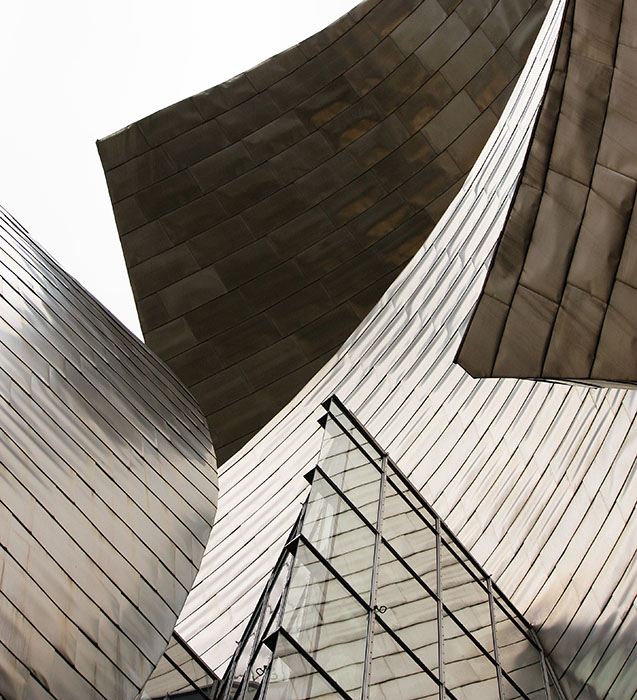
I’m going to analyze how the worldwide well-known Guggenheim Museum Bilbao, one of the four contemporary art museums belonging
to Solomon R. Guggenheim Foundation, makes use of several and diverse Web Communication tools or channels to promote its activity.
Guggenheim Museum Bilbao was founded in 1997 as an indispensable part of a revitalization plan for the city of Bilbao. Its groundbreaking design makes it one of the most famous buildings in Bilbao, as well as in the Basque Country and even in the whole world.
This singular building is one of several museums belonging to the Solomon R. Guggenheim Foundation, a group of very well-known and recognized art galleries which houses a wide collection of modern and contemporary art. Being a famous museum and a reference of new art trends in Spain and Europe, the Guggenheim Museum Bilbao has a narrow relation with the latest communication tools such as Twitter, Facebook and YouTube in order to promote its activity.
If we first focus on one of them, e.g. Twitter, we all agree on thinking that this microblogging site has revolutioned our way of using Internet. Twitter is innovative, appealing and a creative way of making publicity of ourselves. So, museums (apart from many other institutions) could not be less. And their bet has been a success.
According to Leslie Madsen-Brooks, ‘people like information in small chunks’. And what does this mean? Easy. People hardly read documents or texts containing nearly 3,000 words or an article of about ten or eleven pages that talks about an artistic work. Unless the reader is highly interested on the topic, an ordinary person will never read it. So, ‘what can you say about an artifact or phenomenon in 140 characters? ‘ wonders Madsen-Brooks. Museums have to make what they say attractive, make it easy. Easy to read.
Another characteristic that offers Twitter is exclusiveness, something that people really appreciates. And museums know it. Madsen-Brooks affirms it, too: ‘people like to have a customized information stream delivered directly to them’. Receiving some news about activities related to their favourite museum in a direct way makes people feel part of the museum- it seems as if they belong to it. Furthermore, people have the chance to send messages or to ‘tweet’ to the museum in the same way: directly. There is no need to send a letter or to have to take the telephone and call.
Of course, answers to your demands need to be done. It would be useless whether your question (or maybe complaint, as we will see in my WCPlan – in the Twitter section-) has no answer. It could be even worse, as it seems you are not relevant to them. ‘Respond to people’ says Nina Simon, executive director of the Museum of Art & History of Santa Cruz, CA. ‘When I look at the Brooklyn Museum’s Twitter page, I see lots of replies to different people across the platform and I think, “this is an institution that is engaged with the community.”‘. Museums must be interested on their followers and visitors, so that museums show ‘their appreciation for and interest in other people’s comments and discussions‘.

Besides, ‘Once you decide to tweet, make it interesting’ claims again Nina Simon. ‘I scan through about ten tweets and ask myself: is this content interesting enough for me to follow this person?‘ wonders Nina. This last point is essential for museums, among others. Museums are going through a moment where visitor’s number is falling, so this opportunity (modern technologies such as Internet) provides an easy (and a free!) way of advertising and to attract not just people nearby, but from the whole world.
All in all, we can see that Social Networks do have importance on museum’s activity. As we will be able to see in my WCPlan, Guggenheim Museum Bilbao pays a big attention to what we said, but does it make it well? Let’s see it, then.
References:
- ‘People like information in small chunks’ Leslie Madsen-Brooks. http://museumblogging.com/2008/02/14/10-lessons-museums-can-learn-from-twitter/
- ‘What can you say about an artifact or phenomenon in 140 characters?’ Leslie Madsen-Brooks. http://museumblogging.com/2008/02/14/10-lessons-museums-can-learn-from-twitter/
- ‘People like to have a customized information stream delivered directly to them’ Leslie Madsen-Brooks. http://museumblogging.com/2008/02/14/10-lessons-museums-can-learn-from-twitter/
- ‘Respond to people’ Nina Simon. http://museumtwo.blogspot.com/2008/12/open-letter-to-museums-on-twitter.html
- ‘When I look at the Brooklyn Museum’s Twitter page, I see lots of replies to different people across the platform and I think, “this is an institution that is engaged with the community.”‘ Nina Simon. http://museumtwo.blogspot.com/2008/12/open-letter-to-museums-on-twitter.html
- ‘Their appreciation for and interest in other people’s comments and discussions‘ Nina Simon. http://museumtwo.blogspot.com/2008/12/open-letter-to-museums-on-twitter.html
- ‘Once you decide to tweet, make it interesting’ Nina Simon. http://museumtwo.blogspot.com/2008/12/open-letter-to-museums-on-twitter.html
- ‘I scan through about ten tweets and ask myself: is this content interesting enough for me to follow this person?’ Nina Simon. http://museumtwo.blogspot.com/2008/12/open-letter-to-museums-on-twitter.html
Filed under: Arts, Humanities, Microblogging, Social networks, Uncategorized, Web Communication
![]()